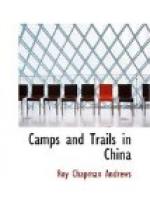It was of paramount importance to pack our specimens before the beginning of the summer rains. They might be expected to break in full violence any day after June 1, and when they really began it would be impossible to get our boxes to Bhamo, for virtually all caravan travel ceases during the wet season. Therefore our second stay at Hui-yao was short and we returned to Teng-yueh on May 24, ending the active field work of the Expedition exactly a year from the time it began with our trip up the Min River to Yeng-ping in Fukien Province.
Mr. Grierson had kindly invited us again to become his guests and no place ever seemed more delightful, after our hot and dusty ride, than his beautiful garden and cool, shady verandah where a dainty tea was served. Our days in Teng-yueh were busy ones, for after the specimens were packed and the boxes sealed it was necessary to wrap them in waterproof covers; moreover, the equipment had to be sorted and sold or discarded, a caravan engaged, and nearly a thousand feet of motion-picture film developed. This was done in the spacious dark room connected with Mr. Grierson’s house which offered a welcome change from the cramped quarters of the tent which we had used for so many months.
Much of the success of our motion film lay in the fact that it was developed within a short time after exposure, for had we attempted to bring or send it to Shanghai, the nearest city with facilities for doing such work, it would inevitably have been ruined by the climatic changes. Although cinematograph photography requires an elaborate and expensive outfit and is a source of endless work, nevertheless, the value of an actual moving record of the life of such remote regions is worth all the trouble it entails.
The Paget natural color plates proved to be eminently satisfactory and were among the most interesting results of the expedition. The stereoscopic effects and the faithful reproduction of the delicate atmospheric shading in the photographs are remarkable. Although the plates had been subjected to a variety of climatic conditions and temperatures by the time the last ones were exposed in Burma, a year and a half after their manufacture, they showed no signs of deterioration even when the ordinary negatives which we brought with us from America had been ruined. The other photographs, some of which are reproduced in this book, speak for themselves.
The entire collections of the Expedition were packed
in forty-one cases and
included the following specimens: 2,100 mammals
800 birds
200 reptiles and batrachians
200 skeletons and formalin preparations
for anatomical study
150 Paget natural color plates
500 photographic negatives
10,000 feet of motion-picture film.




